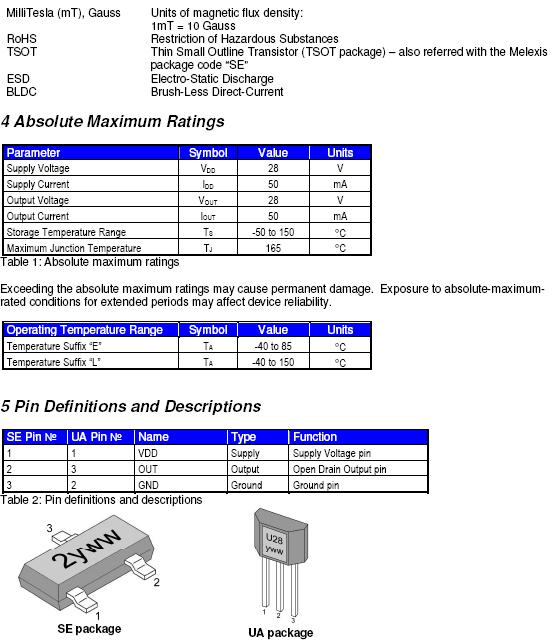


Features and Benefits
Wide operating voltage range from 3.5V to 24V Very high magnetic sensitivity
CMOS technology Chopper-stabilized amplifier stage Low current consumption Open
drain output Thin SOT23 3L and flat TO-92 3L both RoHS Compliant packages
Application Examples
Automotive, Consumer and Industrial Solid-state switch Brushless DC motor commutation
Speed detection Linear position detection Angular position detection Proximity detection
General Description
The Melexis US2881 is a bipolar Hall-effect switch designed in mixed signal
CMOS technology.
The device integrates a voltage regulator , Hall sensor with dynamic offset
cancellation system ,Schmitt trigger and an open-drain output driver , all in
a single package.
Thanks to its wide operating voltage range and extended choice of temperature
range , it is suitable for use in automotive and consumer applications.
The device is delivered in a Thin Small Outline Transistor(TSOT) for surface
mount process and in a Plastic Single In Line (TO-92 flat) for through- hole mount.
Both 3-lead packages are RoHS compliant.
Detailed General Description
Based on mixed signal CMOS technology , Melexis US2881 is a Hall-effect device
with very high magnetic sensitivity. It allows using generic magnets, weak magnets
or larger air gap.
The chopper-stabilized amplifier uses switched capacitor technique to suppress
the offset generally observed with Hall sensors and amplifiers. The CMOS technology
makes this advanced technique possible and contributes to smaller chip size and
lower current consumption than bipolar technology. The small chip size is also an
important factor to minimize the effect of physical stress. This combination results
in more stable magnetic characteristics and enables faster and more precise design.
The wide operating voltage from 3.5V to 24V , "L" and "E" operating temperature
range and low current consumption make this device especially suitable for automotive
and BLDC motor applications.
The output signal is open-drain type. Such output allows simple connectivity
with TTL or CMOS logic by using a pull-up resistor tied between a pull-up voltage
and the device output.
For proper operation, a 100nF bypass capacitor should be placed as close as
possible to the device between the VDD and ground pin.
For reverse voltage protection, it is recommended to connect a resistor or
a diode in series with the VDD pin. When using a resistor , three points are important
:- the resistor has to limit the reverse current to 50mA maximum (VCC / R1 50mA)
- the resulting device supply voltage VDD has to be higher than VDD min (VDD
= VCC - R1.IDD)
- the resistor has to withstand the power dissipated in reverse voltage condition
(PD = VCC2 / R1)
When using a diode, a reverse current cannot flow and the voltage drop is almost
constant( 0.7V )。
Therefore , a 100 /0.25W resistor for 5V application and a diode for higher
supply voltage are recommended. Both solutions provide the required reverse voltage
protection.
When a weak power supply is used or when the device is intended to be used in
noisy environment , it is recommended that figure 13.3 from the Application Information
section is used. The low-pass filter formed by R1 and C1 and the zener diode Z1
bypass the disturbances or voltage spikes occurring on the device supply voltage
VDD. The diode D1 provides additional reverse voltage protection.










 /5
/5 
文章评论(0条评论)
登录后参与讨论